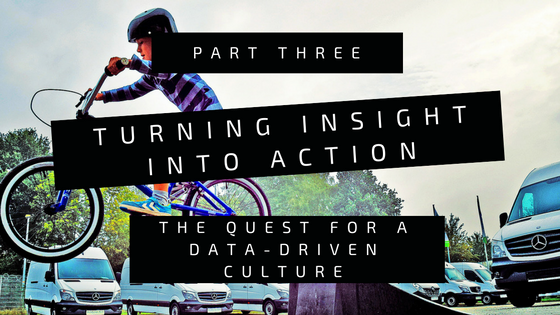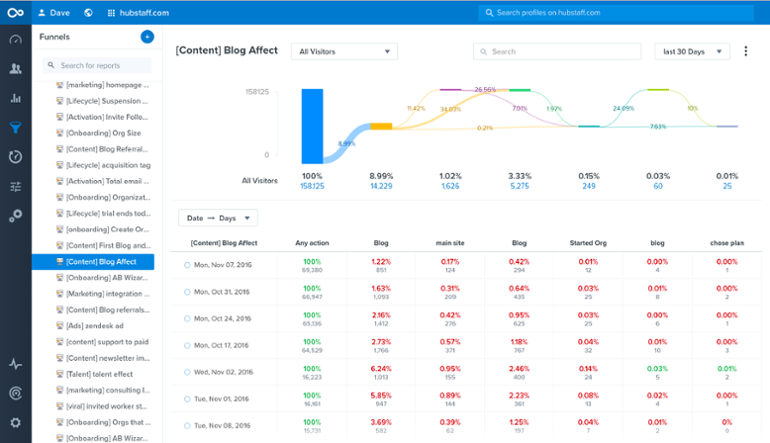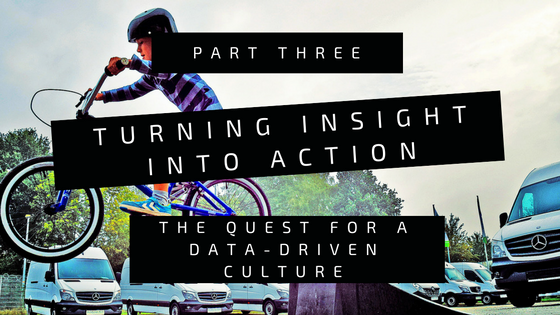Welcome to the final chapter in our three-part series taking marketers on the journey to a Data-Driven Culture. In this series, you’ll learn how to design a data-fueled marketing strategy that removes the gut check from decision making and enables hyper-relevant marketing at a global scale.

According to KPMG Capital, 99 percent of businesses consider data and web analytics to be important to their organizations, yet 85 percent of executives struggle to analyze and interpret their existing data. The lesson? Most businesses now accumulate vast amounts of data, but more often than not, have no idea what to do with it.
“85% of executives struggle to analyze and interpret their existing data.”
Walking through the first two chapters in this series, we discussed how consolidated data is essential to creating data-driven user experiences. Without it, you’re missing the complete view of the customer. And, in this world of customer-centricity, the experience is key to survival.
But, this overarching view of the customer will only get you so far. Insights alone are meaningless unless they enable you to make decisions that have a measurable impact. The businesses challenging the status quo have connected their once isolated analytics and are using this information to drive every aspect of their organization.
What does it mean to turn insight into action?
There are several ways to make your consolidated data insights actionable. One of those used by our customers is automations. Woopra customers can segment and communicate with their users based on an interactive, multidimensional combination of behaviors and characteristics. This could include triggering a personalized message, automating a scheduled task, dynamically adding users to labels and more, in real-time. This gives them the ability to seamlessly automate what once was a manual task or not possible at all without the Woopra platform.

Another way that our customers turn insight into action is through discovery. By visualizing data sets side-by-side that previously could not be compared, questions are raised and curiosity is ignited. You can see where customers are dropping off in the purchasing funnel, identify areas for optimization, monitor campaign effectiveness across channels and instantly make changes to enhance the customer experience.
In this final chapter, I’d like to share the stories of three brands that have leveraged data transparency to boost efficiency and create impactful, timely customer experiences.
AppLovin Identifies and Solves Customer Pain Points in Real-time
AppLovin is a mobile advertising company, founded in 2012, that helps brands develop data-fueled mobile marketing campaigns. Their core product runs entirely on real-time data, so it was essential that their internal business operations were the same.
After integrating their analytics within Woopra, they set up triggers to automate actions based on the behavioral data they were collecting. For example, if a customer were browsing the AppLovin site and encountered an issue, an email alert would automatically be sent to the product team, notifying them of the bug and who encountered it.
“Woopra’s trigger feature also allows us to gather information, package it, and generate internal email alerts to sales, engineering and other internal teams,” said Andrew Karam, AppLovin’s VP of Product. “We’re able to use these triggers to proactively monitor and respond to customers who encountered issues by sending internal notifications to our team.”
By setting up automatic triggers, fueled by a combination of product data and behavioral data, the AppLovin team is able to quickly identify any potential product bugs, proactively reach out to customers having issues and optimize product workflows.
Hubstaff Uses Behavioral Data to Trigger Personalized Content
Hubstaff, a time tracking software for remote employees, was designed to meet the needs of the growing remote workforce. The company enables managers to see what their team members are working on and streamlines the time-tracking process. The result of which is time saved, more open communication and productive, efficient teams.
When Hubstaff came to Woopra, they wanted to be able to communicate with their users based on usage and behaviors taken within the Hubstaff site. After consolidating their data within the Woopra platform, they integrated with Drip.co, an email automation tool, to trigger targeted campaigns based on user behavior.
“One of the things we do is send a webhook from Woopra to Drip.co once we receive three or more pageviews on specific Hubstaff blog categories. For example, we publish posts on payroll, management, marketing, growth and so on. The Drip.co software cannot keep track of all the pageviews, but Woopra does. So, when a lead views three posts within a category such as “payroll,” we know they’re trying to figure out how to pay their people and want specific content on how to do that,” said Dave Nevogt, Co-Founder of Hubstaff.

These users are then tagged within Woopra with the corresponding content category tag. When they’ve reached the appropriate number of views on a category, they’re automatically added to the appropriate email content campaign. This allows Hubstaff to send targeted content to users and prospects based on what they’re interested in at that time.
“Within our app, we don’t have any indicators that these users would be in this segment other than if they tried to set up payroll. But, that could lead to unqualified people,” said Dave. “We simply couldn’t do this without Woopra’s pageview tracking.”
ThingWorx Makes Data Actionable Throughout the Organization
ThingWorx, a PTC company, is a software platform that helps developers to operate, create and service the “things” in the Internet of Things (IoT) era. They partner with an extensive ecosystem to extend the capabilities of smart, connected devices for all industries.
ThingWorx found that they were able to capture massive amounts of information but struggled to make that information actionable. “We tried to capture as much as possible, but none of it was helping to tell the story that we wanted to tell,” said Marc Littman, the Director of Web Strategy and Development at ThingWorx.
“We needed to tell the story of user engagement from initial interest to the actual closing of a deal. I’ve used many different analytics tools and then found Woopra. I set up a trial account and popped the tracking pixel on our site to see what it did. It was mesmerizing! I watched as all of the analytics changed in real-time. Then, created a funnel to see where people were going and what documentation led them to drop off. I added the ability to track when somebody self-identifies, and suddenly, ThingWorx had a framework to tell stories,” he said.
“We’re now getting feedback about what stories our users would like to know, rather than what we think.”
“It helped us understand how the different segments of users were using the site to serve them better,” said Marc. “We’re now getting feedback about what stories our users would like to know, rather than what we think they’d like to hear. I can watch an email campaign in real-time and see how many people are receiving it and how many convert. I can tell instantly if a Twitter or Linkedin campaign drove traffic and conversions. There are numerous questions that we didn’t even know to ask that we’re now able to ask and optimize.”
Conclusion
When customer data is integrated accurately and holistically in one place, employees are can see every aspect of the customer journey and take immediate action. Marketing teams can automate personalized messaging, at scale. Sales teams can identify qualified users based on website activity, product engagement and more. Product teams measure the success of features and quickly identify issues. Customer Success departments can instantly see the behaviors of a user prior to submitting support tickets. And, most importantly, the entire organization has an overarching view of the customer experience.
“A human−centric approach to data that helps people and organizations become more innovative, creative.”
The customer then becomes a personalized and holistic combination actions and attributes that lead to universal knowledge and away from siloed views. It′s a human−centric approach to data that helps people and organizations become more innovative, creative and efficient.
To read the full series, check out part one – Calling all Data: The Quest for a Data-Driven Culture and part two — Applying the Data Glue: The Quest for a Data-Driven Culture.




